#Ford Rouge Plant
Text
Henry Ford's Rouge - @TheHenryFord
Henry Ford’s ultimate goal was to achieve total self-sufficiency by owning, operating and coordinating all the resources needed to produce complete automobiles. His Ford Motor Company once owned 700,000 acres of forest, iron mines and limestone quarries in northern Michigan, Minnesota and Wisconsin. Ford mines covered thousands of acres of coal-rich land in Kentucky, West Virginia and…

View On WordPress
0 notes
Text

Charles Sheeler (July 16, 1883 – May 7, 1965), Criss-Crossed Conveyors, River Rouge Plant, Ford Motor Company, 1927.
336 notes
·
View notes
Text
To Understand Trump’s Staying Power With the White Working Class, Look at Michigan
Supporters remain loyal to former president’s policies, personality
Tuesday February 27, 2024 Wall Street Journal
By Jimmy VielkindFollow and Ariel Zambelich
DEARBORN, Mich.—At its peak, more than 100,000 people streamed in and out of the massive
Ford Motor factory here along the Rouge River. In addition to cars and trucks, the behemoth plant helped mint the American middle class.
The thousands of people who still work here and at other factories across Michigan and other Midwest states helped forge those states’ politics. These blue-collar voters were for many years reliable Democrats, but in 2016 a big group of them, mostly white, helped Donald Trump capture the presidency—including an unexpected win in Michigan.
His supporters said they remain loyal to him thanks to a mix of economic policy proposals and a unique personality that they haven’t seen from many other Republicans, according to recent interviews conducted by The Wall Street Journal for its “Chasing the Base” podcast series.
His policies? They shined. They shined…I made more money than I ever had. My money went further.— James Benson
I just love Trump’s enthusiasm and positivity, he’s positive, he’s enthusiastic…But I like to see an American leader that says we can be great again, we can be number one.— Joe Pizzimenti
The United Auto Workers endorsed President Biden in January, but union officials acknowledge that a sizable portion of their members back Trump. More than 100,000 people in the Detroit metro area work in auto manufacturing alone. It is still home to the headquarters of marquee American auto brands such as Ford, Chrysler and General Motors.
Trump lost Michigan to Biden in 2020. Democrats made up the difference in white-collar suburbs, including Oakland County northwest of Detroit. They made some inroads in blue-collar areas like Macomb County, northeast of Detroit, but Trump still carried the day.
So did former Rep. Andy Levin, a Democrat who won the portion of his district in that county by 36,000 votes. He said Democrats need to be bolder to blunt the GOP. (Levin lost his seat in 2022 due to an intraparty fight following redistricting.)
Republicans were able to peel off people over culture war issues like abortion and guns and LGBTQ rights… They wouldn’t have succeeded if Democrats had—if the average workingclass person could say, well obviously I know what side my bread is buttered on.— Former Rep. Andy Levin
There are other dynamics that will be important in the general election. Biden has dispatched foreign-policy and political advisers to meet with Muslim and Arab-American leaders upset with the administration’s handling of the war in Gaza. The mayor of Dearborn, home to a major Arab-American population, has said the Biden administration “failed to act to protect the lives of innocent men, women and children.”
John Sellek, a Republican political consultant, said a loss of support from Arab-American and younger voters over the Middle East conflict was as important for Trump as his continued hold on the white working-class.
Macomb County is a bastion of the latter group. It is home to strip malls, sports bars and massive auto plants that cropped up as people moved from Detroit to the suburbs in the latter part of the 20th century.
Trump brought many new voices into the Republican Party here, and that has caused a fight about who controls it at the state level. Stacy Van Oast, 59 years old, said at a monthly coffee hour held at the Macomb County GOP office that one result has been dysfunction.
Peter Kiszczyc emigrated from Poland in 1984 and worked for decades at area factories. He said it was great that the former president has broadened the party’s appeal.
He’s changing the party…He’s appealing to many blue-collar workers especially, not only [in] Macomb county, but Michigan So I am Christian, [a] patriot, and I support Donald Trump 100%.— Peter Kiszczyc
#Wall Street Journal#Michigan#Trump Supporters#president trump#trump#trump 2024#repost#america first#americans first#ivanka#america#donald trump#Blue collar workers#blue collar worker#art#nature#landscape#fashion#DIY#LOL#GIF#Food Art#Detroit#America
16 notes
·
View notes
Photo

Ford Motor Company's Rouge Steel plant, aka "The Rouge." Dearborn, Michigan, 1937.
25 notes
·
View notes
Text
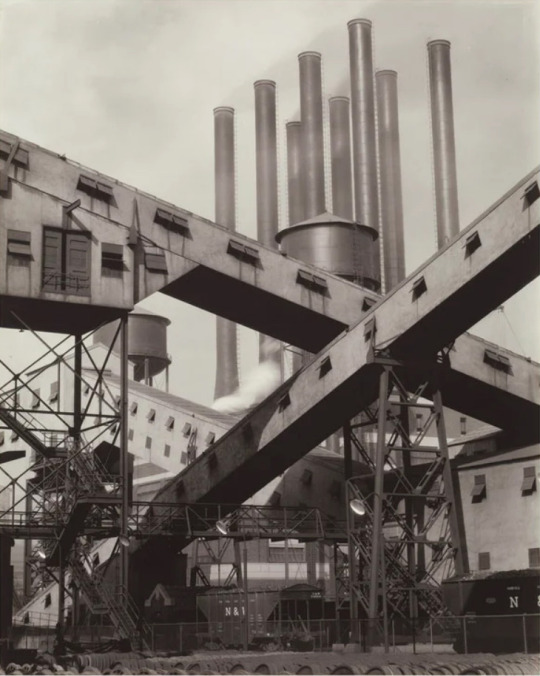
Criss-Crossed Conveyors, River Rouge Plant, Ford Motor Company (1927, photograph) | Charles Sheeler
20 notes
·
View notes
Text
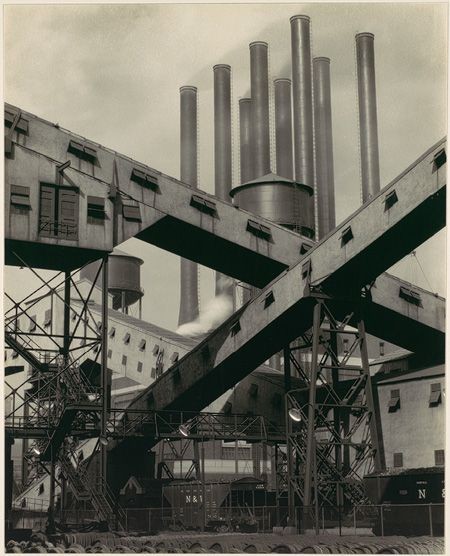
Criss-Crossed Conveyers, River Rouge Plant, Ford Motor Company (1927) by Charles Sheeler
3 notes
·
View notes
Text
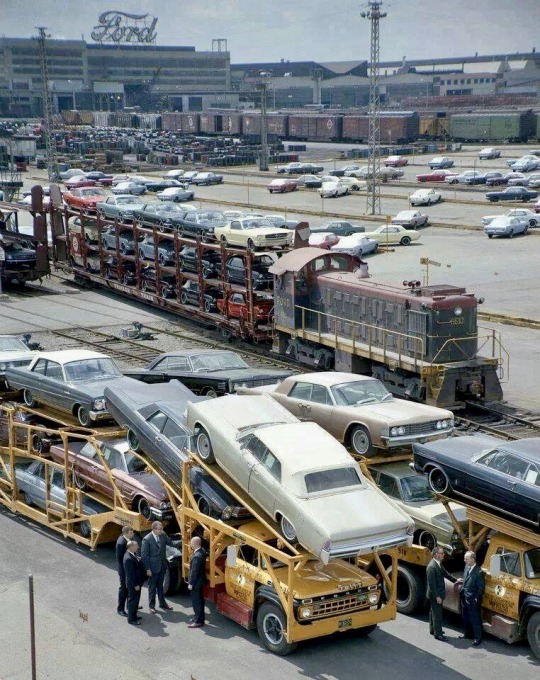
Railhead at Ford's River Rouge plant in Dearborn, Michigan, mid 1960s. Awful lot of men in suits doing diddly-squat. So no change there...
2 notes
·
View notes
Text
A Detroit Black History Month Perspective - New Detroit
In 1914, Henry Ford decided to pay his workers, through a profit-sharing plan, $5.00 a day to stabilize a volatile workforce. When he makes this decision, his workforce of 14,000 at his Highland Park plant is 75% white foreign-born. At the time, Ford, like all automobile manufacturers, refused to hire Black people. From 1914 to 1917, Ford only employed about 200 Black workers, mostly janitors, out of 15,000 workers at his Highland Park plant.
By 1917, the first significant migration of African Americans from the South is well underway, with 25,000 blacks arriving in Detroit. At this time, other than a few janitors, Ford does not hire Black employees; therefore, we must conclude the notion that Black workers came to Detroit because of the $5.00 a day job at Ford is not entirely accurate. A closer look reveals racism is pushing Black families out of the South and they are not coming North solely for jobs.
Black families are leaving the South because of oppression and racism. The generation that is coming are the children of enslaved people. Unlike their parents, they are unwilling to tolerate the lynching, the denial of education, basic decency and respect in their daily lives, so they head to Northern cities, including Detroit.
However, in 1917, Ford dramatically changed his exclusionary hiring policies, not for altruistic reasons, but purely for economic gain. Ford is challenged with building the massive Ford Rouge Plant, his growing debt to minority stockholders, the formidable IRS, and his mostly European immigrant workforce is pushing for unions.
Fearing a loss of control over his workforce, Ford turns to Black and white workers from the South. Ford would come to view Black employees as the ideal workforce. Black residents needed jobs; they had no interest in unions because white unions had excluded them, so in the 1920s, Ford began to hire Black workers in large numbers.
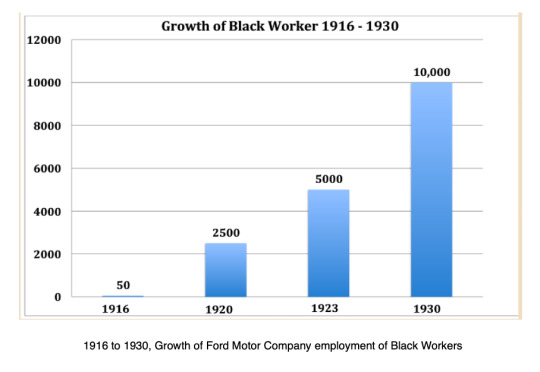
By 1930, 100,000 people work at the massive Ford Rouge plant, and 10% (10,000) are Black. There are more Black employees at Ford than all of the other automobile manufacturers and their suppliers combined. With no formal education, Black Detroiters are probably making more money at that time than their peers around the world. Moreover, this workforce attracted other Black professionals from around the nation to Detroit, black lawyers, doctors, dentists, and educators, and as a result, there was the development of the Black business community – Paradise Valley. So, Ford’s business decision has a historical domino effect.
While this was progressive, the opportunity to obtain a job at Ford did not translate into a long-term wealth opportunity for the African American community as it did for white European immigrants and whites from the South. Ill-educated whites from Europe and the South were able to invest part of their wages from their auto jobs into buying their family home.
In Detroit, from 1923 to 1928, 50,000 new homes were built in the city of Detroit proper for white auto workers. Realtors refused to sell or rent any of these homes to Black residents. Black people in Detroit, regardless of their income or professional status, could not obtain a mortgage. For example, a white worker from Ford could obtain a mortgage before a Black schoolteacher could. Black workers were making more money than they had at any other time or place on earth; however, they could not obtain a mortgage for a home and build long-term wealth for their families. This provides us with insight into how businesses can have a powerful effect on addressing historical injustice.
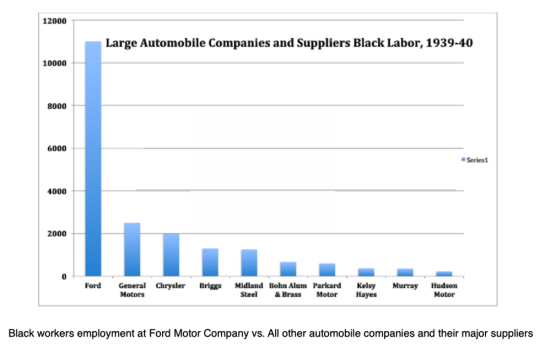
On a smaller scale here in Detroit, the massive challenge still exists of providing an undereducated population of African Americans with good-paying jobs. If left unchecked, history will again repeat itself with the opening of the new FCA plant on Detroit’s eastside and the promise of nearly 5,000 jobs. Like the auto industry of the past, this project will bring suppliers and factories to the city, creating more jobs and the potential to spawn new business development.
However, without long-term vision and understanding history, FCA and similar ventures could, without intervention, stymie generational change. What is the vision for the eastside in housing, education, healthcare so this opportunity changes lives for the long-term?
I know personally how historical events can have long-term consequences and impact future generations. My father served in the Navy during World War II. In 1947, he came to Detroit from Mississippi; his family had been sharecroppers, cultivating cotton. He obtained a job at Chrysler Corporation, and for more than 30 years worked at the Jefferson Avenue plant. He married and had seven sons. Our family resided on the lower eastside of Detroit, a few blocks from the Belle Isle Bridge. Under our mother’s guidance, my brothers and I all attended the Detroit Public Schools and completed high school and went on to college.
Today, my brothers and I are nearing retirement. We have led very successful careers as an OB-GYN, an engineer, a dentist, an artist/museum specialist, an educator, and building contractor. Our oldest brother died in Vietnam (Navy) serving this nation.
All of our children have attended or are currently attending some of the leading colleges and universities in the nation. This was primarily made possible due to the opportunity our father had employed as a factory worker in the mid-1950s. The story of my family is not unique but was repeated throughout Detroit during the Post World War II period, and it is a historical narrative that provides a vision for the future.
#Detroit#New Detroit#racism#white violence#white flight#labor#Black history in michigan#A Detroit Black History Month Perspective
2 notes
·
View notes
Text







Today in Great Lakes shipping history June 12th.
1900: TASHMOO (steel side-wheel excursion steamer, 308 foot, 1,344 gross tons, built in 1900, at Wyandotte, Michigan) entered regular service for the White Star Line at Detroit, Michigan, on 12 June 1900.
1900: On 12 June 1900, the UNIQUE (wooden propeller, 163 foot, 381 gross tons, built in 1894, at Marine City, Michigan) was sold at public auction at St. Clair, Michigan to satisfy a mortgage. W. J. Laidlaw of Ogdensburg, New York purchased her for $20,000 for the Rapid Transit Co. to run between Ogdensburg and Kingston, Ontario. In 1904, her upper cabins were removed and she was rebuilt as a yacht. She lasted until 1915, when she burned in New York City harbor.
1917: CARL D. BRADLEY (Hull#718) cleared Lorain, Ohio, in her gray and white livery in 1917, on her maiden voyage light bound for Calcite, Michigan, to load limestone. She was the first Great Lakes commercial ship equipped with both Morse code telegraphy as well as ship-to-shore radio in 1922, which was standard on only 20 vessels by 1924.
1959: the BENSON FORD ran aground in the Amherstburg Channel on her upbound trip with coal for the Rouge Plant. After five days of lightering and with tug assistance, she was freed. Damage amounted to 41 bottom plates, which took 30 days to repair.
2023: Shades of pink and purple welcome in American Integrity as the footer arrives Duluth for fuel.
2023: Algoma Guardian heads inbound the Superior Entry at sunrise.
2023: Burns Harbor, visible on the horizon, departed shortly before the Guardian made her entrance.
Boat Nerd
15 notes
·
View notes
Photo
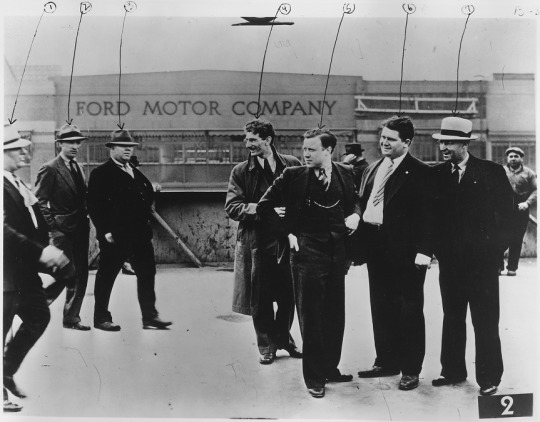
Walter Reuther, Richard Frankensteen, and other @UAW leaders stand outside the Ford Motor Company’s River Rouge Plant. On the left, Ford security forces are about to assault the union organizers, 5/26/1937.
Series: Franklin D. Roosevelt Library Public Domain Photographs, 1882 - 1962
Collection: Franklin D. Roosevelt Library Public Domain Photographs, 1882 - 1962
Image description: Three men, not smiling, walk toward a group of four men who have just finished posing for a photo. In the background there is a building with “FORD MOTOR COMPANY” on it.
#archivesgov#May 26#1937#1930s#unions#labor#united auto workers#ford motor company#detroit#battle of the overpass
55 notes
·
View notes
Text
What is Justice? A Short Discussion of a Complicated Question
"The world progresses, in the slow and halting manner in which it does progress, only in proportion to the moral energy exerted by the men and women living in it."
-Jane Addams (Nobel Peace Prize Winner, 1930)

According to the Stanford Encyclopedia of Philosophy, “justice can take a number of different forms, depending on the practical context in which it is being applied." Anecdotally, one of the most common occurrences of world justice is in terms of laws and the judicial system, but it also arises throughout discussions of politics, theology, and ethics. In the context of law, this can be seen as establishing statutes that hold people accountable for actions that harm others. In the context of politics, this can be seen in terms like social justice which refer to creating a society of equal opportunity and availability of resources. In terms of philosophy and ethics, this idea of justice could be seen as the moral responsibility to treat people fairly and to not practice discrimination. Although the term justice can be referred to in a different manner throughout each of these contexts, the main ideas that seem to hold true through all of them is that justice means establishing a basis of equality, and impartiality, between people so they have a fair chance of flourishing without the restriction of someone or something else. While it may be difficult to pinpoint an exact definition of the term, it remains even harder to pinpoint a way in which someone can cultivate it. Though this is true, we have often pointed to Aristotle’s notion of the need of role models as the way, and possibly only way, to cultivate virtues like justice in the self. Historical figures of virtue allow for virtues like justice to change from an abstract term to one of tangible character traits and actions.

One of the historical figures that may be used to model the virtue of justice is Walter Reuther. Framing justice through the lens of social justice and creating a society of equality and fairness shows the need of a historical figure who fought for fairness and equality throughout even the most difficult of challenges. Walter Ruther was one of the leaders to organize the newly formed United Auto Workers Union in Detroit between 1936 and 1937. As he was elected in the UAW’s executive board, he represented around 30,000 auto workers and was a key leader in the 1937 sit-down strikes in Flint, Michigan to convince General Motors to raise wages to sustainable levels and to officially recognize the union. He then tried to unionize Ford’s River Rouge plant in Dearborn, Michigan, but when he, and other UAW organizers, were handing out pamphlets outside the building Ford sent a group of men to beat Reuther and the other organizers. Though he nearly died in the incident, Reuther did not stop fighting for workers' rights. By 1948, he bargained with GM to agree to bring wages up to the price of living, establish grievance procedures for workers, enforce safely standards, and even grant workers up to 95% of their salary in the case that they were laid off, pioneering the way for many modern worker’s rights. In 1963, Reuther stood by Martin Luther King Jr. throughout his speech during the March on Washington, marched with King and John Lewis from Selma to Montgomery, and even sat on the National Advisory Board for the NAACP. Later on, he also supported Cesar Chavez and the United Farmworkers Union. Reuther fought for social justice and reforms for countless types of people in order to establish the virtue of justice in society.
Both Galtung and Maslow depict the need for safety and physiological needs in order to promote wellbeing. Reuther’s example shows how the virtue of justice is important to making sure these needs are met. Reuther fought for justice in order for laborers to have safe working conditions and fair wages. Without these, there is no way for an individual to flourish let alone survive. Without the virtue of justice, people are left on both a literal and figurative starvation diet to satisfy their needs. They do not have access to fairness and equality that gives them Maslow’s foundation to start their journey towards flourishing. Justice provides an individual with the common ground to healthily satisfy their basic needs so they can work on establishing true well-being. Furthermore, practicing the virtue of justice in the self may be a way for people to develop Seligman’s ideas of positive emotions, engagement, and positive relationships as practicing justice means viewing others as equals. In turn, this gives people the humility to create relationships and foster engagement since they have this equal view.
The decision on where to “enter the forest” on the topic of justice is a very complicated one. As today’s modern definition of justice may fall into one dictated by the sense of law (whether divine or political) it may be helpful to enter the forest with Plato’s Republic where he defines a more intrinsic version of justice outside of external laws. If looking through the lens of social justice, as I chose to do with the Reuther example, it may be helpful to enter the forest in a time of great change to social justice and equality. Whether this be with labor reforms, the suffrage movements, the civil rights movement or another time of advancements towards equality, one could choose to enter the forest during a time of little justice and work their way through the efforts of people who embark on the slow but virtuous path towards achieving it.
2 notes
·
View notes
Text
The Ford Rotunda: Gateway to the Rouge @FordMotorCompany
IN 1936, FORD’S WORLD’S FAIR EXPOSITION FOUND A PERMANENT HOME IN DEARBORN AND BECAME ONE OF THE MOST POPULAR TOURIST ATTRACTIONS IN THE UNITED STATES.
“FORD will participate in the 1934 World’s Fair at Chicago!” exclaimed the March edition of the Ford News. That same spring, Ford Motor Company opened the doors on a new pavilion. Sitting on 11 acres of land along the Lake Michigan shoreline, the…

View On WordPress
#1930&039;s#1934 Worlds Fair#1940&039;s#1950&039;s#Ford Motor Company#River Rouge Plant#The Ford Rotunda Gateway to the Rouge
0 notes
Text

Amazing historic photo Ford Motor Company at its River Rouge Plant Dearborn, Michigan taken in 1965
Rarely do we come across a photo that has this much goodness going on it at once, but here we are. For starters, the picture was taken in front of the historic Ford River Rouge Complex, which was the largest integrated factory in the world when it was completed in 1928. More than 100,000 workers were employed there, even during the Great Depression in the 1930s.
Over the years, The Rouge churned out all sorts of automobile models, tractors, boats, aircraft components, tires, and various other products. The Model A was produced there, as well as the Ford Thunderbird, Mercury Capri, and four decades of Ford Mustang models. Today, The Rouge site is home to The Blue Oval’s Rouge Center, which includes the Ford Dearborn Truck Plant, where the Ford F-150 is built.
This picture is full of Ford models, including a Galaxie and Falcon, a handful of Lincolns, and a whole slew of Mustangs. But everything else in the photo is a Blue Oval product as well – including the car haulers, which we bet a lot of folks would love to get their hands on today. Even the train has “Ford” printed on the side, because of course it does.
And of course, there are some snazzy looking businessmen standing by the trucks, doing what we can only imagine is, well, business. At least that’s what it looks like. Regardless, it’s nice to take a trip back to this very different, very cool era, if only for a few precious minutes.
0 notes
Text
Ford's Electric Vehicle Experiment Was an Open Wound That Could Never Heal

Electric vehicles are the future, they said. They’re the quintessential pain in the backside that isn’t worth the money and a resource drainer for the working family. Who am I kidding? These cars aren’t for people like us. It’s for rich, wealthy, woke whites who think they’re doing their part in going green. They’re really setting up their families to freeze to death when the battery dies as temperatures dip.
In Canada, one man detailed how these vehicles were the greatest scam of the modern era, given the $130,000-plus investment he sunk into this cockamamie lefty idea. When the EV line costs your company billions, maybe that’s a sign that this goes beyond overhead and research costs—customers don’t want it. For every Ford F-150 Lightning sold, which Joe Biden was infamously photographed driving early in his term, it cost Ford $36,000. So, how is the car giant going to fix this? They will shift their focus toward making more gas-powered cars—the ones that make money (via NY Post):
— DC_Draino (@DC_Draino) January 25, 2024
Ford announced that it would be increasing production of gas-powered pickup trucks while cutting down on its electric F-150 Lightning https://t.co/PaNW37y5o6 pic.twitter.com/zSxyOfi3jJ— Reuters (@Reuters) January 20, 2024
Recommended
Ford Motor said Friday it would reduce production of its F-150 Lightning pickup truck, as demand for electric vehicles softens.
The No. 2 US automaker said it would cut production at its Michigan Rouge Electric Vehicle Center to one shift starting April 1. In October, the automaker said it would temporarily cut one of three shifts at the Michigan plant that builds the electric F-150 Lightning pickup truck.
The announcement is the latest sign of slowing demand for EV trucks. General Motors in October postponed the opening of a $4 billion electric truck plant in Michigan for a year.
[…]
Ford said a few dozen employees could be impacted at component plants supporting F-150 Lightning production.
Ford lost an estimated $36,000 on each of the 36,000 EVs it delivered to dealers in the third quarter, the company said in October, after announcing earlier it would slow the ramp-up of money-losing EVs, shifting investment to Ford’s commercial vehicle unit and citing plans to quadruple sales of gas-electric hybrids over the next five years.
These cars' batteries also need to be charged for what seems like every other hour. Second, you need to upgrade your grid and install charging stations at your home and place of employment. That expense soars into the tens of thousands on top of the overpriced and laughably unreliable vehicle whose battery life is halved when it gets colder. Leah wrote about how winter has become the grim reaper for Teslas in Chicago. These cars just die.
Until we’ve successfully duplicated what Keanu Reeves did in Chain Reaction, just buy a gas-powered car.
Recommended
Trending on Townhall Videos
0 notes
Text
Restaurant Roundup: New restaurants coming to metro-Detroit; DRA Green Lantern Pizza deal makes the list

Posted by Crain's Detroit Business | Jay Davis | December 8, 2023
Canton gets state's second Raising Cane's- Another popular southern-based chicken chain is planting its flag in Southeast Michigan.
Baton Rouge, Louisiana-based Raising Cane’s is coming to Canton Township after the township board of trustees on Nov. 28 approved plans for a location at 44250 Ford Road. The chicken joint will take over a space previously occupied by TGI Fridays.
Raising Cane’s features chicken tenders, chicken sandwiches, coleslaw, Texas toast, and sweet tea by the jug. The Canton Raising Cane’s will be around 3,700 square feet, according to Township documents. The restaurant will have dine-in and drive-thru service. The space will include about 1,650-square-feet for indoor dining, and an outdoor patio area.
Raising Cane’s officials did not respond to a Crain’s request for more information.
The Canton location will be Michigan’s second, following an East Lansing location that opened in October 2022 at 301 E. Grand River Ave.

New Grand River Brewery location opens today in Clawson- A bar and restaurant with roots in mid- and West Michigan is now open in an Oakland County suburb.
Jackson-based Grand River Brewery opens today at 1 E. 14 Mile Road in Clawson. The new brewery, which also has locations in Jackson and Marshall, will operate out of the space that previously housed restaurant Pumachug. Pumachug closed in November 2022.
The space features sit-down dining on one side, with seating for 50, and a 49-seat bar in an adjoining space. Grand River Brewery will have a staff of 50 employees. Grand River Brewery will offer 15 draft beers, and five taps featuring batched cocktails. Food offered will include a Nashville Hot Chicken sandwich, burgers, woodfire pizza and steaks.
Grand River Brewery, owned by Justin Dalenberg, opened its first location in 2013 in Jackson. The Marshall location followed in 2018.
The Clawson Grand River Brewery will be open 4 p.m.-midnight daily at the outset. Additional hours will be added after the brewery opens, company COO Bryce Davenport previously told Crain's.

New Irish pub now open in Clawson- The sister bar of a popular Rochester hangout is now open in Clawson.
Gus’ Snug opened on Dec. 4 at 38 S. Main St. in Clawson. The new Clawson spot is a venture from Dimitry Goyfman and Kevin VanDyke, the co-owners of O'Connor's Public House. The opening of Gus’ Snug is the first expansion for O'Connor's in its 19-year history. Gus’ Snug takes over a space previously occupied by Moose Winooski’s.
At 3,000 square feet, the Clawson spot at 38 S. Main St. is about half the size of O'Connor's, Goyfman said. Gus' Snug is about 3,000-square-feet, nearly half the size of Rochester's O’Connor’s. The Clawson pub has seating for 100 guests, including a 20-seat bar. Plans call for a 70-seat outdoor patio and biergarten in the rear, and a 30-seat outdoor space on Main Street.
The menu includes corned beef from Grobbel's and Fairway Packing Co. in Detroit's Eastern Market, as well as fish and chips and shepherd's pie. Gus' Snug's has nearly 20 draft beer options that include Irish favorites like Guinness, Harp and Smithwick's.
Goyfman previously told Crain’s he and VanDyke invested about $700,000 into the business and are projecting about $2 million in annual revenues.

Green Lantern Pizza expanding into Waterford-Green Lantern Pizza is set to add a new location in Oakland County.
Green Lantern in November signed a 10-year lease on a 1,400-square-foot space inside the Highland Row Shopping Center in Waterford, according to a news release. The Waterford location will serve as a carryout and delivery store.
The Waterford Green Lantern will be the company’s 12th location. A Livonia carryout and delivery store is planned, too, according to the Green Lantern website. Green Lantern currently operates seven carryout and delivery locations and sit-down restaurants and bars in Berkley, Clinton Township, and Madison Heights.
To read about the 10-year lease transaction for Green Lantern: https://dominionra.com/news.php/735538740804632576
To read this article on Crain's Detroit Business, visit https://www.crainsdetroit.com/food-drink/raising-canes-chicken-planned-canton-township
0 notes
Text

On December 8, 1942, Detroit architect Albert Kahn died at his home at the age of 73. Kahn and the firm bearing his name designed and built more than 2,000 buildings, mostly for Ford Motor Company and General Motors.
Born in Germany in 1869. Kahn and his family moved to the United States when he was 11 and settled in Detroit. As a teen, he got a job as an architect's apprentice. In 1902, after working at a number of architectural firms in Detroit, Kahn started his own company.
While building factories for Packard, Kahn and his brother, a structural engineer, found that using reinforced concrete instead of wood or masonry accelerated the construction of manufacturing plants significantly. It also made them sturdier and less prone to fires. Also, reinforced-concrete buildings needed fewer load-bearing walls, freeing up floor space for massive industrial equipment. Kahn's first concrete factory, Packard Shop No. 10, still stands today on East Grand Boulevard in Detroit.
Ford's Highland Park plant, built in 1909, was Kahn's first for Henry Ford. The factory used elevators and dumbwaiters to spread the Model T assembly line over several floors, but most of his later factories were huge one-story structures, including Ford's colossus, "The Rouge" (1916) and the half-mile-long Willow Run plant that built Ford's B-24 bombers in Ypsilanti.
Though Kahn designed a number of non-factory buildings, including the Ford and GM office towers in downtown Detroit, he is best known for building factories that reflected the needs of the industrial age. We still celebrate his innovations today. #ThisDayInAutoHeritage
https://www.facebook.com/motorcities?mibextid=rS40aB7S9Ucbxw6v
1 note
·
View note